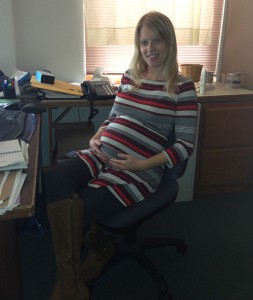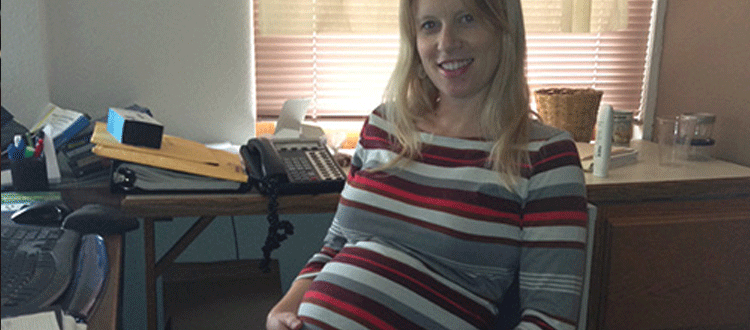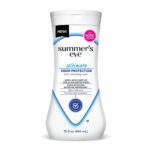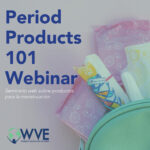Toxic Chemicals to Avoid During Pregnancy
 |
|
Jamie McConnell |
This blog was originally published on September 19, 2013, and inspired our just-released fact sheet: Toxic Chemicals to Avoid Before, During, and After Pregnancy. For the most up-to-date tips, please visit this fact sheet and our Green Parent Guide for creating a non-toxic home for baby and you.
For the last six years, I have been working to reduce women’s exposure to toxic chemicals through my work at Women’s Voices for the Earth. What I do has taken on new meaning since I became pregnant. Because of my job, I’m very keyed into sources of exposure to toxic chemicals, and this knowledge has guided what I bring into my home.
In a lot of ways—and this is probably a result of being immersed in this work every day—I was kind of living in a bubble. I didn’t realize how many women don’t have access to basic information on how to protect themselves (and their unborn child) from exposure to toxic chemicals.
This really hit home when I went to my first O.B. appointment. I was given a big plastic bag full of information on pre-natal vitamins, pre-natal yoga classes, advertisements for diapers and bottles, a couple of pregnancy magazines—they even gave me a 400-page pregnancy book on birthing! In this big pile of stuff the one thing that was glaringly missing, in my mind, was a simple list of what chemicals to try to avoid during pregnancy.
When I actually met with my health practitioner, she did walk me through a list of things to avoid during my pregnancy: certain types of cheeses, fish high in mercury, cat poop, Ibuprofen, lunch meats, alcohol, caffeine, etc. But not one mention of avoiding toxic chemicals from household products. Where’s the advice on problematic chemicals found in plastics, cleaning products and cosmetics, for example? The omission made me think of the millions of women who don’t get this information from their doctor and are left to scour the internet for resources—or they just remain in the dark. Many women may think that if their doctor doesn’t explicitly tell them to avoid something, it’s probably safe, right? Wrong.

More and more research is linking chemicals like BPA and certain types of phthalates, for example, to birth defects, diabetes, obesity, and even ADHD. If I had my way, every OB office and midwife in the U.S. would distribute this information to their patients. In a move that made headlines this year, the Royal College of Obstetricians and Gynaecologists (RCOG) in Britain stated that women should be made aware of sources of exposure to chemicals in order to reduce the risks to the developing fetus.
While there are a few new brochures on toxic chemicals available for U.S. health care practitioners to hand out to their pregnant patients – such as Planned Parenthood’s Green Choices webpages and the University of California San Francisco’s Toxic Matters brochure—unfortunately so far, it’s the rare lucky patient that gets to see one.
Until O.B.s in the U.S. routinely offer this information to their patients, women will need to find this information on their own. If I were to create a list of what exposures to avoid during pregnancy ,it would probably look something like this (this list is partially taken from WVE’s Ten Ways to Reduce Exposure):
1. Make Your Own Cleaning Products
- It’s easy, fun, and cheap to make non-toxic cleaners from safe and effective ingredients like vinegar and baking soda. Find recipes here.
THE FACTS: Certain chemicals in cleaning products have been linked to reduced fertility, birth defects, increased risk of breast cancer, asthma, and hormone disruption.
2. Avoid Synthetic Fragrance
- Look for cleaners, laundry detergents, and personal care products labeled “fragrance-free” Warning: “unscented” does not mean fragrance-free!
- Discontinue use of air fresheners. Click here for tips to reduce odors around the home.
THE FACTS: Synthetic fragrance can be made up hundreds of chemicals, all of which are kept secret from consumers. Common fragrance chemicals include phthalates (reproductive and developmental harm) and synthetic musks (break down the body’s defenses against other toxic exposures, linked to increased risk of breast cancer).
3. Give Your Personal Care Products a Makeover
- Read the label to avoid chemicals like parabens, sodium laureth sulfate, and oxybenzone.
- Check the Skin Deep database at www.cosmeticsdatabase.com to find safer products.
THE FACTS: Over 12,000 chemicals are used in personal care products—89% of them haven’t been reviewed for safety.
4. Go “BPA-Free”
- Ditch the canned foods and opt for fresh or frozen fruits and vegetables instead.
- Look for products packaged in glass or lined cardboard instead of cans.
- Look for plastics labeled “BPA-free.”
- Don’t take paper receipts from ATMS, grocery stores etc, if you don’t need them
THE FACTS: Bisphenol-A (BPA) is commonly found in can liners, plastic products and coated on paper receipts. BPA exposure is linked to a host of hormone-related health impacts such as increased risk of cancer, infertility, obesity and diabetes.
5. Watch Out for Triclosan
- Avoid anti-bacterial hand soap with triclosan listed on the label.
- Reduce your use of disinfectant products.
THE FACTS: Triclosan is a hormone disruptor that builds up in our bodies, and it’s been found in blood and breast milk. Studies show that it’s actually no more effective at removing germs or preventing illness that plain soap and water.
6. Choose Plastics with the Recycle Symbols #4 & #5
- Look for plastic products with these symbols signifying PVC-free plastics.
- Use glass jars or bowls to store food.
- Never microwave plastic.
THE FACTS: Polyvinyl chloride (PVC), known as the poison plastic, is found in plastic products from toys and cookware to shower curtains. PVC is linked to hormone disruption, reproductive and developmental harm, and other serious health problems.
7. Keep Chemicals Out of the House
- Take of your shoes before entering your house to avoid tracking in oils and chemicals from the street outside.
- Use a door mat to catch dirt at the door.
- Dust with a micro-fiber cloth or wet cloth and vacuum your house regularly (with a HEPA-filter vacuum if you can).
- Don’t use pesticides to kill bugs or rodents in your home
- Don’t use chemical flea colors, dips, or baths on your pet
THE FACTS: Shoes can track in toxic chemicals like lawn pesticides, coal tar from a driveway, etc. Dust carries harmful chemicals that shed off of household furniture, electronics, and other household products.
8. Turn Down the Heat on Non-Stick Cookware
- Keep the stove at or below medium heat when using Teflon or non-stick cookware.
- Opt for cast iron or stainless steel pans for cooking when possible.
THE FACTS: Teflon releases perfluorooctanoic acid (PFOA) when heated to 450 degrees. PFOA is linked to developmental harm and cancer.
9. Avoid exposure to paint.
- Have your partner or a friend paint the nursery
- Have them use a low or no VOC paint (HomeDepot, Lowes, and Ace Hardware carry a wide variety).
THE FACTS: Paint can contain volatile organic compounds (or VOCs) which have been linked to cancer and respiratory irritation. Though I’m sure you’re tempted to help your partner paint the nursery—don’t!—even if you use low or no VOC paint they may still contain other chemicals of concern such as heavy metals in pigments, or preservatives which prevent mold growth.
10. When possible, try to eat organic food.
- Check out the Environmental Working Group’s Guide to Pesticides in Produce to find veggies and fruits that are low in pesticides (after all, not everyone can afford to buy organic all the time!)
THE FACTS: Fruits and vegetables can contain harmful pesticides linked to birth defects and reproductive harm.
11. Avoid getting certain beauty services done during pregnancy.
- Beauty services like Brazilian Blowout (and other hair straightening symptoms), hair coloring, and perms can release nasty chemicals.
- Check out WVE’s list of salon ingredients to avoid. Make sure your stylist isn’t using products that contain these ingredients.
THE FACTS: Some hair and nail salon treatments can contain chemicals like formaldehyde, toluene, phthalates, and other nasties that are linked to birth defects, reproductive problems and even cancer.
12. Check out WVE’s Green Parent Guide
- The guide is a how-to for detoxing your home in preparation for baby. Included in the guide are some inexpensive, do it yourself recipes to try out with friends!
Lastly, if this list of tips seems overwhelming and exhausting…take a deep breath. There is so much new stuff to learn and know during pregnancy, and you can only do the best that you can do given your individual circumstances. Take comfort in knowing that taking care of your health, by getting good sleep, eating healthy, and getting exercise also goes a long way in boosting your body’s defenses against toxic chemical exposure that can be hard to control.
Are there any tips you have for avoiding harmful exposure? Leave a comment!







Thank you for this article, Jamie, and congrats! As a Community Educator with the Kentucky Environmental Foundation and an Ava Anderson Consultant, I too have worked hard over the last several years to educate others about this important issue. I am sure you have also been blown off by health care professionals of all kinds, as I have. We don’t dare mention retinyl palmitate or hydroquinone to a dermatologist or bring up hormone disruptors with our OBs. I would love to see a group effort to educate physicians, whether by speaking at continuing ed meetings, in med schools, or by publishing a journal directed at healthcare professionals with all the latest on chemicals and health. I would be happy to help with any such efforts if you know of any in the works. Reaching the medical community is the crucial next step in our effort to protect our families and our environment from toxic chemicals. Bravo to you and WVE!
Great post Jamie! And congratulations on your pregnancy 🙂 I published a 12 step guide here http://www.mommygreenest.com/pregnant-12-tips-to-protect-your-baby-for-life/ and am working on a Mommy Greenest book for pre and post. Good news is that the AAP and ACOG (is that the right abbrev?) are moving towards educating patients about toxic chemicals. Yay!
Great article Jamie! You are so right, the focus on toxics to avoid is totally missing. To your great list, I would add flame retardant chemicals. To help minimze exposure, avoid products made of polyurethane foam, prefer products with cotton, down, wool or polyester which are not typically treated with flame retardants. Flame retardants are also in baby products such as changing pads, crib wedges, high chairs, etc. So definitely look for those filled with polyester or cotton. Best of luck on your pregnancy!
You’ve written an excellent article! I have a teenage daughter and I’m so pleased people are writing about this more and more. I know this is a sensitive topic, but have you thought about toxic chemicals in medical products during pregnancy? Many of these consumer products (nasal sprays, eye drops, vaccines, skin creams) still contain mercury and other nasties like formaldehyde. Peer-reviewed research shows injecting toxic chemicals while pregnant, especially in combinations like in flu products, may be problematic. Those products still contain a mix of thimerosal (mercury), formaldehyde, polysorbate 80, and antibiotics like gentamicin sulphate. The primary reason this may not be advisable is that the fetus is in rapid growth mode and has not yet developed the blood brain barrier needed to protect it’s developing brain. Did your health practitioner talk with you about avoiding these too? Thanks again for the great article!
As a holistic practitioner, here in Missoula, who is chemically sensitive I really appreciate all you guys do. This was a great article Jamie. Thank you so much for sharing it with us.
Great article and congratulations on your pregnancy! As a health care provider, I would be really interested in learning more about the health risks with the products you have mentioned. Do you have any links to any research studies that have been done? I would love to spend some time reading through the data and become better informed. Thanks!
Fantastic article! Easy, simple steps… I believe strongly in decreasing the toxins in most conventional beauty products (shampoo, lotions, creams) – what goes on, goes in! One other tip I find useful: filtering tap water (Brita or Pure) and carrying with me in a steel container. The plastic in bottled water can easily leach into to water. Thanks for all you are doing!
Thank you so much! I am a midwife and did my research as a student on xenoestrogens and the effects during pregnancy and the lifespan….I really appreciate your work and it has renewed my passion to really make this information clear and accessible to clients. I get a bit discouraged when clients walk in sometimes with their plastic water bottles. It can be a tricky balance sometimes wanting to encourage and applaud them for staying hydrated, while gently suggesting that they might go about it in a different manner. Folks aren’t always receptive, but all we can do is our best to provide the education and alternative choices. Well done and thank you again!!
Thank you for these great suggestions for those who are pregnant. I often hear at my Norwex Healthy Home parties where I teach people to clean with just water that they are pregnant and had been struggling with trying to figure out how to clean their home. I just wish women would also take care of their bodies when they are not pregnant.
Hi Jamie,
Congrats on the expected little one, how awesome!! Congrats as well on the splendid article. I’ve tweeted it and posted it on my FB.
Would you like me to send you some complimentary Shoosha Truly Organic http://www.shooshatrue.com
Shoosha is the only complete line of USDA certified food grade organic skin care developed by Moms to protect families from chemicals. Special products for expectant/new Moms and babies. Just let me know!
Thrilled for you!
Kindest regards,
Nancy (nancy@shooshatrue.com)
Great article! Thank you for writing this….Just my opinion that I feel something major was left out…so many OB’s recommend pregnant women get the flu vaccine. It was recommended to me during both pregnancies. I felt like you that there was all this info on things to avoid but why then would this toxic vaccine be suggested. If we shouldn’t eat certain fish due to containing mercury, why would it be ok to have a vaccine put right into our bloodstream with mercury in it. They still use mercury in many vaccines although lots of people don’t realize it.
The flu vaccine like any other is made with horrible chemicals, gmo ingredients, other human and non-human DNA, infected foreign DNA, preservatives, etc…..much worse than eating fish or eating non-organic fruits and veggies.
SO if we are trying to avoid chemicals on our skin or by eating them, isn’t it important not to let them be injected into our bloodstream. Plus you don’t have to look far to see how many woman have miscarried just after getting the flu vaccine alone. I just felt this should have been in the top 10. It makes me sad women get vaccines while pregnant due to the very complex developmental stages a baby is going through in the womb. To me, no vaccine is safe. Especially to an unborn child or baby.
Great tips to help new moms get started. If only this info. had been available years ago…
Dear Jamie. I hope you don’t mind that I have linked this marvelous article to my hubpage on bisphenol-A in the environment. http://debbybruck.hubpages.com/hub/bisphenol-A-in-plastic-hazardous-to-health We need to educate the public, authorities in charge of manufacturing practices and mothers-to-be. Blessings, Debby
Thanks for the wonderful blog Jamie! This would be great for everyone to share with their OB/GYNs. Or better yet, imagine med schools including this kind of info in their curriculum. And perhaps, some day, we’ll get manufacturers to shift away from using these toxins in their products.
Great news! Today the American College of Obstetricians and Gynecologists and the American Society for Reproductive Health released a statement advocating for stronger government policies to identify and reduce sources of toxic exposure.This is a great step forward and hopefully will lead to more OB’s giving information to their patients about ways to avoid toxic chemical exposure.
You can read the statement here: http://www.acog.org/About_ACOG/News_Room/News_Releases/2013/Environmental_Chemicals_Harm_Reproductive_Health
Thanks for all your comments and tips! I enjoyed reading them.
Jamie McConnell
Director of Programs and Policy
Women’s Voices for the Earth
Great and insightful article. I don’t plan on having kids, but have friends and acquaintances that are. I’ll definitely be passing your article around. A lot of these chemicals I’d want to steer clear of anyway. Growing your own organic garden would be a sure fire way to keep costs down while being able to eat organic.
Scaremongering to a ridiculous degree. There’s a reason why this information wasn’t included in your pregnancy pack given by your medical professional, and it’s that there is no sure and indisputable evidence for any of these claims. Good use of the phrases ‘can cause’ and ‘linked to’…your opinions really do look like facts to the untrained eye. I dare you to tell a mother whose child has ADHD or cancer that her behaviour during pregnancy may have caused her child’s illness. If you do, you deserve whatever reaction you get! Don’t link it to pregnancy and expect mothers of ill children to be happy. It’s irresponsible and reckless. What a disappointment.
Pingback : Avoiding toxins during pregnancy (and beyond) | My little, green family
Hi Jane,
Thanks for your comment. I’d like to point out that the American College of Obstetricians and Gynecologists and the American Society for Reproductive Health recently released the following statement “Toxic chemicals in the environment harm our ability to reproduce, negatively affect pregnancies, and are associated with numerous other long-term health problems.” What I’m talking about in my blog is not “scaremongering,” it’s a legitimate concern that is also shared by the medical community. You can read the full statement here: http://www.acog.org/About_ACOG/News_Room/News_Releases/2013/Environmental_Chemicals_Harm_Reproductive_Health
Jamie McConnell
Director of Programs and Policy
Women’s Voices for the Earth
I’ve been recently wondering about the identical point personally recently. Glad to see someone on the same wavelength! Nice article.
Pingback : Toxic Chemicals to Avoid During Pregnancy « MomsRising Blog
Cooking soft drink makes a superb cleaner and deodorizer.
Mix the corn meal to the soil underneath the plant and out to the
drip line. You can use kill mold spray to really have a straight forward tidy up.
Thank you for this info! Does anyone have any sites that have a list of non-toxic, eco-friendly items for baby showers? I’m due in 5 weeks and hoping to promote non-toxic items in my registry.
Great article! I’m working on an MPH and after an environmental health class gave up quite a few of the items on your list. It’s hard to do at first, but knowing that we’d be trying soon was enough to get me motivated. Where we continued to have trouble in cutting the habit was in carpet (we have a very messy puppy) and bathtub cleaner. After some nifty home recipes (involving natures miracle AKA vinegar) the tub is sparkly clean and we found a shop that sold VOC free carpet shampoo. Now that we’re a few months into my pregnancy I couldn’t be happier we made the switch. I love that you close the article with a good reality check, but until the US cracks down on the chemicals we are surrounded by each person needs to remain vigilant (pregnant or not).
Great article. One other one that I think is worth mention is upholstry – most couches and mattresses have fire retardant chemicals (which don’t actually stop fires, they only slow them down a tiny bit) that are toxic. They have these in copious amounts too, so your head is close to the mattress, and skin is touching these chemicals basically all night long, and anytime you sit on the couch you kick these up into the air.
One of the dangers many women don’t realize is the water they are consuming. Fluoridated water is known to have neurological effects and this is especially true to pregnant women and infants. An example, if an infant swallows a serving size of toothpaste, you are told to contact the Poison control center. In reality one 8 ounce glass of fluoridated water contains the same amount. There even greater risk when mothers formula feed using tap water. Please look into this information of the neurotic effects of this element in excess. There are also other toxic substances like pharmaceutical drugs and heavy metals are hazardous without proper filtration.
Great article, I am a double board certified OB/Gyn and High Risk Pregnancy MD. To address this risk as pointed out recently by ACOG and WHO I have created the worlds first cosmetic line for pregnancy: VSacharMD.com
Safe nontoxic cosmetics for pregnancy. I wanted to give pregnant women a safe alternative. As you mentioned toxins can enter your system for the sir (pollution) our diets (pesticides) and your skin with cosmetics. Our line has no artificial preservatives or parabens phthalates, triclosan, or even bismuth chloride.
Please visit us at http://www.VSacharMD.com for more medical info on our products and to see our complete product line. .
Please feel free to contact us, and once again, great post!
Best Wishes
V Sachar MD
Hi my name is Govana and I work in a place where I’m exposed to paint and a liquid to thin it and I breath it for 12 hrs 5 days a week and my doctor said it was safe to work with it…i think he’s wrong cause I get sick when I’m breathing it..is it safe to work with pain during pregnancy?
I was concerned and aware of all of the above
Till I found out I was ingesting formaldehyde
daily in the fish I was eating.
I do live in South East Asia but a lot of seafood
imported to The States and Oz from China and
Asia is laced with formaldehyde to preserve it.
This is a great article. Thank you for this inspiring article.
Fantastic article ! I would also add avoid anything with phthalates . They have been linked to premature births . I wish the OBs and health departments would share this information with the pregnant women they serve.
Hey, thanks for the forum.Really thank you!
Useful comments – I Appreciate the information , Does anyone know where I could possibly get access to a template a form example to fill in ?
Thanks so much for the info, great article. I was also wondering about ‘new car smell’. I’m currently 7 weeks pregnant and the company I am working for has given me a new car (VW Amrock). It smell quite toxic so I’m driving with the windows down and fan on during the day to limit the exposure but I’m sure it’s not ideal. I’d be interested to see some information on toxins in new cars and how bad they are as well as suggestions for limiting exposure.
I think that ventilation is very important. Keep windows open as much as you can and use cleaners just before you leave the house so that odors can evaporate.
The solution to pollution is dilution , we used to say!
It comes to the ingredients in your skincare and makeup, you’re probably more than a little lost. We don’t blame you. Ingredient lists can be daunting, so we did the research and simplified it for you. Skip these for the next nine months.A lightening agent; abstain from hydroquinone, idrochinone and quinol/1-4 dihydroxy benzene/1-4 hydroxy benzene.
Very very good article. Thank you.